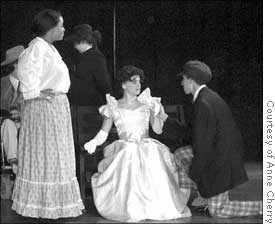
| << Front page | Arts | December 9, 2005 |
Tintypes Presents a Musical View of History
 |
||
| Ladies and the Tramp: The cast of Tintypes provided humor in its entertaining depiction of America during the late 19th and early 20th centuries. | ||
Last weekend’s production of Tintypes reminded me very much of the “It’s a Small World” ride in Disney Land. On the ride, passengers journey into a mysterious land animated by over 300 diverse mechanical characters who sing “It’s a Small World” over and over again in a glorious “celebration of global unity.” After the ride, one has a sense that all of the characters will remain in their little land forever and ever, singing their little song, doing their little dance.
After seeing the production of Tintypes, I felt rather convinced that the characters were still in Wilder Main, singing their songs about America. The show is made up of reincarnations of important historical figures from the late 19th and early 20th centuries. There was Theodore Roosevelt, the president (sophomore Matthew Scarborough); Anna Held, the risqué vaudeville girl with an 18-inch waist (sophomore Anne Cherry); Susannah, poster-girl for civil rights (Rosa Gadsden); Emma Goldman, the Jewish anarchist (sophomore Emily Tinawi) and Charlie, a hoot of an immigrant based loosely on Charlie Chaplin (first-year Richard Lawrence).
When I entered Wilder Main, the five characters had already mounted the stage and were frozen in various poses. They looked like immobile wax models of themselves, and I had to fight the urge to go poke them to test their resilience. It was this beginning setup that first gave me the impression that these characters were authentic reincarnations of the historical figures after whom they were modeled. It was as if the director, senior Beau Mahurin, had somehow brought them back from the dead and forced them to sing and dance on command, like the lovely animatronic children from Disney.
The entire show consisted of nearly 50 song and dance numbers celebrating and satirizing America in the period of 1889 to 1918, perhaps better known as “The Age of Innocence.” During this time, the country was preparing itself for an exciting new century, filled to the brim with progressive ideas and technology.
In his director’s note, Mahurin, a lover of musical theater and ghosts of the past, notes that this musical revue of history is “important because history repeats itself and therefore can give us insight into the present and the future.” Furthermore, he explains that “if we want to keep history alive, we must explore our memories, in this case, national memories.” The arts are often the best way to do this.
In Tintypes, Mahurin skillfully crafted history on the stage. He went to great lengths to create a world for this play. He did a large amount of research in order to understand the period and the historical figures represented, which he displayed on a bulletin board for the audience to peruse.
Mahurin also made an effort to construct the context of Tintypes for the audience in Wilder Main. All of the people assisting with the play (ticket-takers, house manager, production crew, etc.) were in costume from the period. There was also a bowl of lemonade and cookies served during intermission, which, I believe, were popular parlor foods from this era.
Scarborough did an excellent job satirizing Roosevelt with an array of splendid facial expressions. His wheelchair was no obstacle to his performance. Some may have even dismissed it as a prop, confusing which presidential Roosevelt was handicapped. The wheelchair occasionally even added to his performance, becoming a source of humor as he whizzed around the stage, dancing wholeheartedly with his upper body.
Although Lawrence looked a little too scruffy to be typecast as Chaplin, he did a good job of imitating his type of humor. There is also something to be said for his level of enthusiasm, which seemed impossibly high as he smiled his way through the show.
Gasden seemed to lean toward a more serious interpretation of her character, but this worked well and provided a foil for the other more comically-inclined actors.
Cherry seemed authentic as a sexed-up showgirl, but Tinawi seemed to upstage her in the raciness category during the number “What It Takes To Make Me Love You — You’ve Got It” with Scarborough, in which there was an ample amount of phallic dance movements and groping involved.
Tintypes was one of those productions a person might call charming or fun, especially for the musical enthusiast, as it was almost purely comprised of song and dance. The musicians in the pit also did an excellent job.
All of these elements, along with the “It’s A Small World” syndrome affecting the actors, created the distinct sense of an alternate reality that the audience was able to enter for two hours.
The only obstacle to this was a noisy gurgling heater and a slightly over-lit
theater. And that’s saying something.
About us
Subscriptions
Advertising